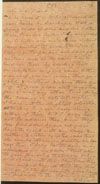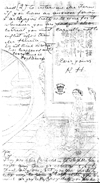Mahatma Letter No. 84: Difference between revisions
No edit summary |
No edit summary |
||
| (3 intermediate revisions by one other user not shown) | |||
| Line 66: | Line 66: | ||
== Context and background == | == Context and background == | ||
This letter is really a “cover letter” for the one to follow. | |||
Dharbagiri Nath was a mystical name for one of the Mahatma K.H.’s chelas, Gwala K. Deb. But there is also a strange connection with another individual — a probationary chela of the Mahatma K.H. — known in the literature as Babaji, or sometimes Bawajee. This very odd situation is explained by Sven Eek in Damodar, p. 537 (see also LBS, from 135 to 140, also p. 336, et seq.) See the notes to Letter No. 53 (ML-136). | |||
At about the time of this letter and probably in connection with it — the Mahatma K.H. desired to send two chelas to Sinnett, then at Simla. He selected one of his pupils, Gwala K. Deb, who was probably a Tibetan, and R. Keshava Pillai, an Inspector of Police at Nellore, who had become a probationary lay chela and who was known as Chandra Cusho — a name given him by the Mahatma K.H. Deb was in Tibet at the time, undergoing certain occult training, and was unable to go in his physical body. Babaji consented to have Deb use his body for the occasion. This was much to his credit and spiritual benefit. It was, however, Deb’s mystical name which was Dharbagiri Nath, and it seems that Babaji continued to use the name after the experience was ended. The mix-up is a strange one, and when one meets with the name Dharbagiri Nath, as one does several times in the letters, it is difficult to know whether it is really Gwala K. Deb, the Tibetan Chela, or Babaji. However, when the Mahatma refers to him as “the little man” or “my little man” he is probably referring to Babaji (whether as Deb or as himself) as he was of very small stature. | |||
Chandra Cusho was a Tibetan name given by the Mahatma to R. Keshava Pillai. He was put on probation by the Mahatma but progressed no further. Later, he lost interest in the Theosophical Society. He received several letters from the Mahatma which, some years later, he gave to Olcott. They are included in LMW, Series 2, pp. 115-119. One letter of the group has some connection with Letter No. 84. The Mahatma tells him that he is sending “Deb” to Simla with some letters for Mr. Sinnett (whom he calls “the best of all”) and asks whether Brother Keshu (Chandra Cusho) will accompany and help him. “The task is easy,” says the Mahatma, “and there will not be much for either to do but be silent, and successfully play their parts. The Mahatma promises him that if he carries out this mission successfully, he (K.H.) will take him under his special protection and permit some of the secrets to be taught to him. Undoubtedly the mission was to deliver Letters No. 84 and 85A and 85B. | |||
== Physical description of letter == | == Physical description of letter == | ||
| Line 79: | Line 85: | ||
== Commentary about this letter == | == Commentary about this letter == | ||
== Notes == | == Notes == | ||
| Line 89: | Line 94: | ||
[[Category:ML with images]] | [[Category:ML with images]] | ||
[[Category:ML needs commentary]] | [[Category:ML needs commentary]] | ||
[[es:CM84]] | |||
Latest revision as of 12:39, 4 November 2024
| Quick Facts | |
|---|---|
| People involved | |
| Written by: | Djual Khool |
| Received by: | A. P. Sinnett |
| Sent via: | unknown |
| Dates | |
| Written on: | unknown |
| Received on: | late August 1882 |
| Other dates: | unknown |
| Places | |
| Sent from: | unknown |
| Received at: | Simla, India |
| Via: | unknown |
This is Letter No. 84 in The Mahatma Letters to A. P. Sinnett, 4th chronological edition. It corresponds to Letter No. 111 in Barker numbering. Djual Khool describes the conditions under which a package will be delivered to Sinnett's house. See below for Context and background.
< Prev letter chrono
Next letter chrono >
< Prev letter Barker
Next letter Barker >
Page 1 transcription, image, and notes
|
My dear friend, The present will be delivered at your house by Darbhagiri Nath, a young Chela of mine, and his brother Chela, Chandra Cusho. They are forbidden to enter anyone's house without being invited to do so. Therefore, I pray you to pardon our savage customs and, at the same time to humour them by sending them an invitation in your name, either now — if you can receive them privately and without risking their meeting at your place with any stranger; or — at any other time during the evening, or late at night. I have not the slightest objection to Mrs. S your lady seeing either of them; but I pray her not to address them, since they are forbidden by our religious laws to speak with any lady — their mothers and sisters excepted — and that she would otherwise greatly embarrass them. I pray her to do so in my name, and for my sake. I trust also to your friendship that none but you will speak with them. They have their mission and beyond that they must not go (1) to deliver into your hands my "answers to the famous contradictions" |
NOTES: |
Page 2
|
and (2) to interview Mr. Fern. If you have an answer for me, Darbhagiri Nath will come for it whenever you are ready. I also entreat you most earnestly not to inflict upon them Mr. Hume. Do not think of what has happened until everything is explained. Ever yours, P.S. — They are also forbidden to shake hands with any man or woman i.e. to touch anyone; but you can invite my little man to come and talk with you as much as you like provided you are discreet. |
NOTES: |
Context and background
This letter is really a “cover letter” for the one to follow.
Dharbagiri Nath was a mystical name for one of the Mahatma K.H.’s chelas, Gwala K. Deb. But there is also a strange connection with another individual — a probationary chela of the Mahatma K.H. — known in the literature as Babaji, or sometimes Bawajee. This very odd situation is explained by Sven Eek in Damodar, p. 537 (see also LBS, from 135 to 140, also p. 336, et seq.) See the notes to Letter No. 53 (ML-136).
At about the time of this letter and probably in connection with it — the Mahatma K.H. desired to send two chelas to Sinnett, then at Simla. He selected one of his pupils, Gwala K. Deb, who was probably a Tibetan, and R. Keshava Pillai, an Inspector of Police at Nellore, who had become a probationary lay chela and who was known as Chandra Cusho — a name given him by the Mahatma K.H. Deb was in Tibet at the time, undergoing certain occult training, and was unable to go in his physical body. Babaji consented to have Deb use his body for the occasion. This was much to his credit and spiritual benefit. It was, however, Deb’s mystical name which was Dharbagiri Nath, and it seems that Babaji continued to use the name after the experience was ended. The mix-up is a strange one, and when one meets with the name Dharbagiri Nath, as one does several times in the letters, it is difficult to know whether it is really Gwala K. Deb, the Tibetan Chela, or Babaji. However, when the Mahatma refers to him as “the little man” or “my little man” he is probably referring to Babaji (whether as Deb or as himself) as he was of very small stature.
Chandra Cusho was a Tibetan name given by the Mahatma to R. Keshava Pillai. He was put on probation by the Mahatma but progressed no further. Later, he lost interest in the Theosophical Society. He received several letters from the Mahatma which, some years later, he gave to Olcott. They are included in LMW, Series 2, pp. 115-119. One letter of the group has some connection with Letter No. 84. The Mahatma tells him that he is sending “Deb” to Simla with some letters for Mr. Sinnett (whom he calls “the best of all”) and asks whether Brother Keshu (Chandra Cusho) will accompany and help him. “The task is easy,” says the Mahatma, “and there will not be much for either to do but be silent, and successfully play their parts. The Mahatma promises him that if he carries out this mission successfully, he (K.H.) will take him under his special protection and permit some of the secrets to be taught to him. Undoubtedly the mission was to deliver Letters No. 84 and 85A and 85B.
Physical description of letter
The original is in the British Library, Folio 3. According to George Linton and Virginia Hanson, the letter was written:
On a single folded sheet of coral colored paper, about 4" x 9" [10.2 x 22.9 cm], which has a Chinese wood-block print on the back. The writing is in fine lettering in black ink and is continued on the back. The postscript is below the print, in blue pencil.[1]
Publication history
Commentary about this letter
Notes
- ↑ George E. Linton and Virginia Hanson, eds., Readers Guide to The Mahatma Letters to A. P. Sinnett (Adyar, Chennai, India: Theosophical Publishing House, 1972), 142.

